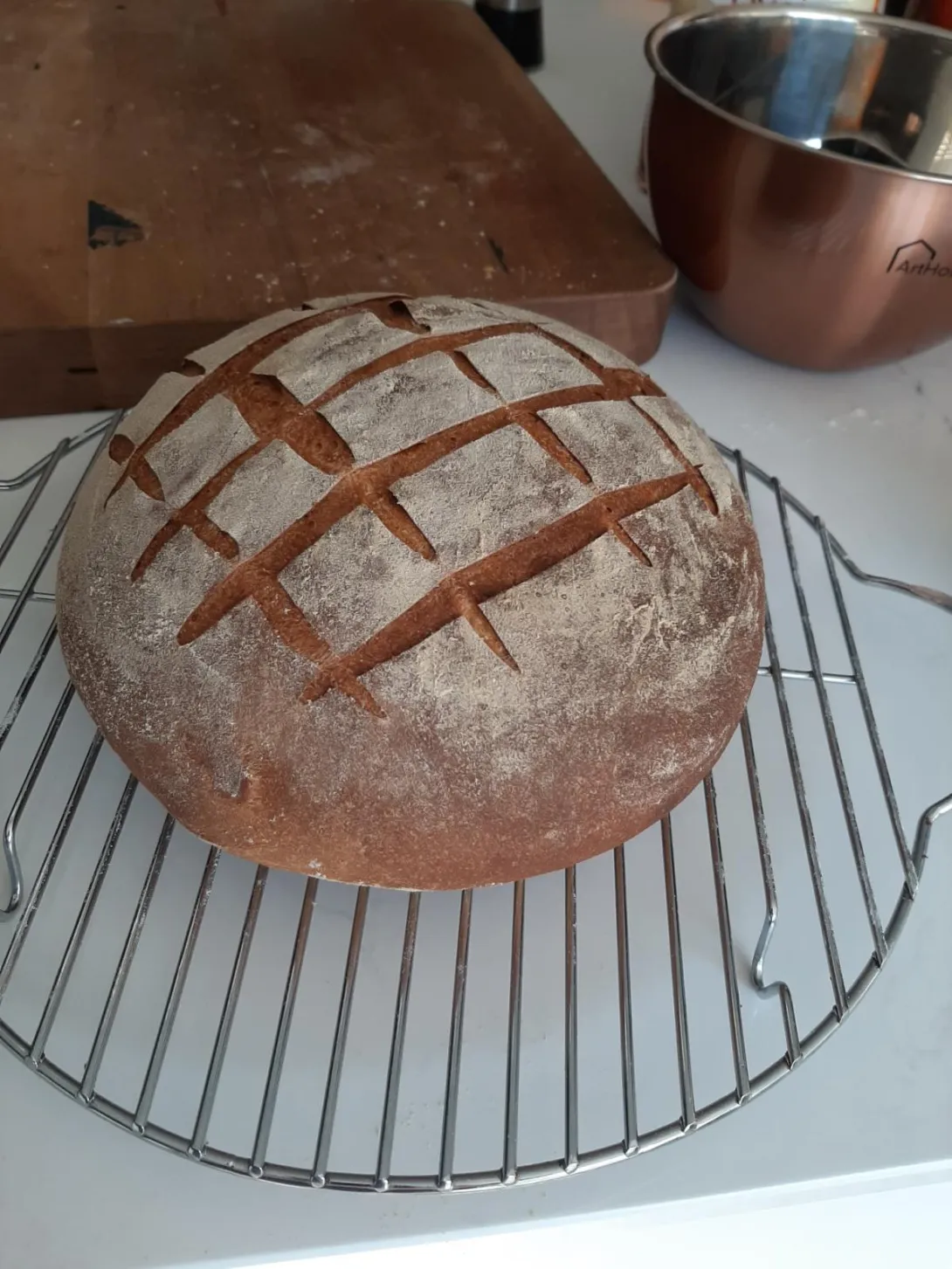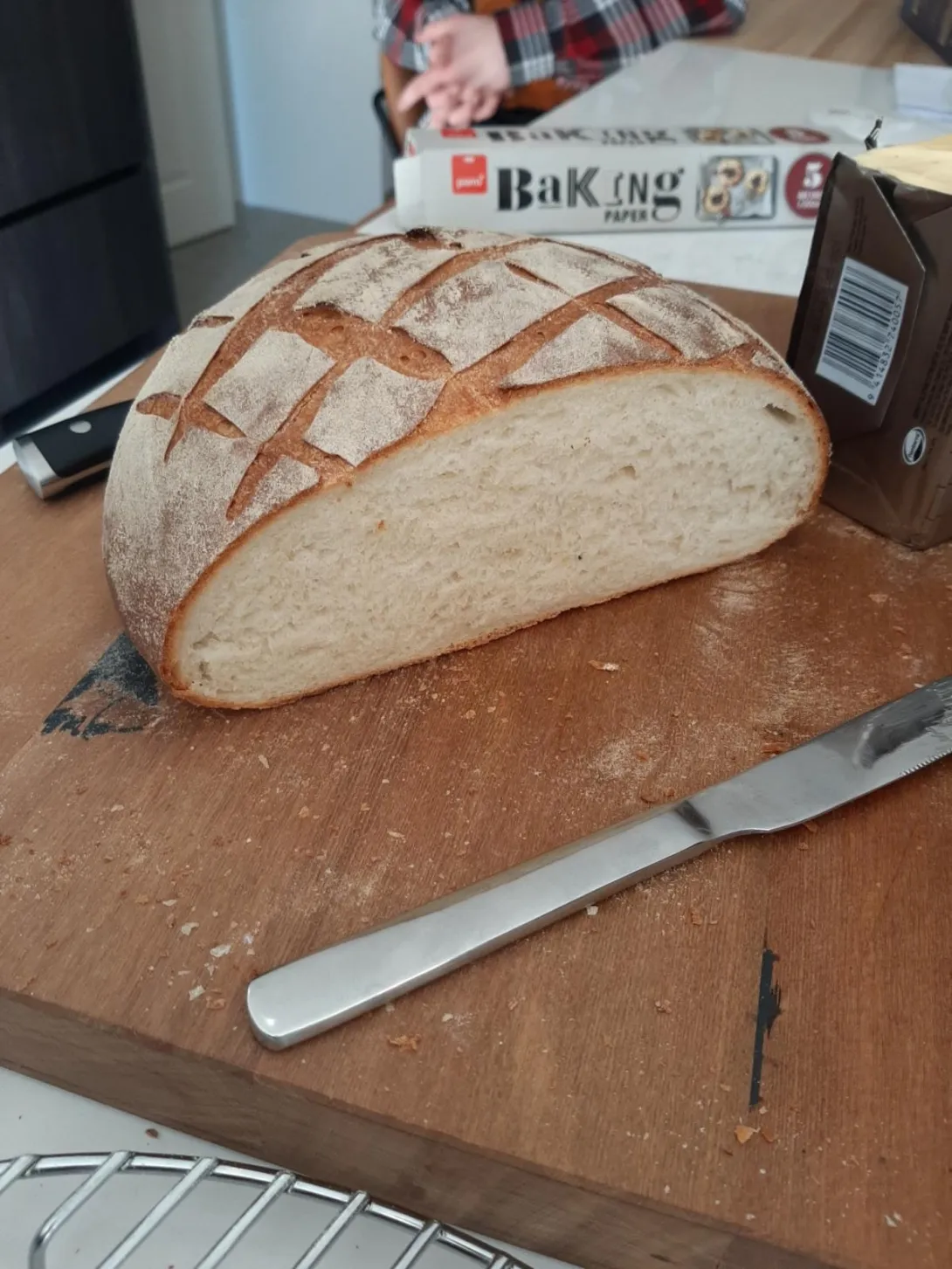
Hi folks. Lovely forum. Have been enjoying reading through the myriad of topics - much appreciated. Decided to take up bread making during the national Covid lockdown over here so have been baking a loaf every few days. First time I've done this from scratch. Lucky enough to have a semi newer kitchen and invested in a bosch combi steam oven as part of that upgrade so everything has been done in that. While the family has loved the bread and it doesn't last long, I'm a bit OCD on crusts - crunchier the better. Been making Cob's primarily from Paul Hollywood recipe as the first type. I'm trying to understand how to achieve 3 things please - get a big ear on the loaf, be able to alter the air holes inside and finally, a tooth breaking crust :) I appreciate it may be many things to bring that together so thought it better to ask now instead of 400 loafs down the line. Have attached a few pics. Am generally baking the bread on a tray but today tried a pre heated cast iron pan that certainly browned the base better. Also been playing about with higher temps for first 10 minutes of baking etc to see if i can get more caramelisation on the crust as well. Happy for feedback. Got plenty of pics and happy to answer any questions
Cheers
Ged
To give better feedback, we need to know your recipe and baking information, i.e., time, temperature, how long steam, etc.
Sure.
Usual mix up. Knead till smooth. Ball it, bowl it and clingfilm on top. Prove between 40min to 60min depending on kitchen temp. Knock back. Fold over a few times. Shape back up. Ball it and place on baking tray. About 45 mins later it get scored then goes into oven. Roughly 30 min bake. Temp 220c / 425F. Bosch Series 8 Oven - Steam level 3 (max) for first 10 mins until crust starts to form / brown. Stop steam for final 20min then remove around the 30min mark. I get a fairly closed crumb as well. Noticed as well it swells / springs a little in the oven but nothing too great. Thankyou :)
Image

1 steam shorter maybe 5 minutes
2 start baking hotter like 250 °C
3 under proof a little.
Bu it looks like a great loaf as it now.
Thanks for those ideas. When you say underprove are you talking about the first main rise or the second rise after knocking it back ? Thanks
It does not matter I think.
As long there is some food left for the yeast.
https://youtu.be/7rsnmv5FvKE
double the amount for a reason?
Hi Mini.
Sorry. Not sure what you mean. I took the recipe from a well known UK baker. Are you suggesting I use less yeast/
Thanks
Ged
Im suggesting less yeast. Look at the package, there should be a suggested amount of flour written on it. If it says something like for use with 500g flour, then try it. The times may be different, so watch the dough. See how it comes out for you.
For tooth breaking crust, site search same. Try: hard crust, how to soften crust (reverse engineer) or too much steam, or not enough steam.
Thankyou. I'll do some reading :)
Looks like the formula was designed for quick fermentation/proof:
"Prove between 40min to 60min depending on kitchen temp. Knock back. Fold over a few times. Shape back up. Ball it and place on baking tray. About 45 mins later it get scored then goes into oven."
The small-hole airy (foamy? some people say?) crumb is typical of more-yeast/less-time recipes.
Nothing wrong with it if short rising times are your goal. But short rising times work against other typical goals for artisan bread.
Ged, could you please post all the ingredients listed in the "official" ingredients list from your package of flour?
I don't mean what is advertised on the front of the package. I mean the official ingredients list that is in fine print, usually under the official Nutrition Info box on the side or back of the package.
We are an international group here, and most of us (including me) forget that certain critical ingredients can vary, or be omitted, by differing countries. And it is not obvious or commonly known to beginning home-bakers in some countries that extra ingredients might need to be added for bread.
(note to Mini: I'm thinking of malted flour or amylase.)
Greetings! Looks like a lovely loaf! However, if you are wanting tooth-breaking crusts, I think you will have better luck with a different recipe as any time you add butter (or milk) to a bread recipe, you are essentially making an 'enriched' loaf, like standard sandwich bread, so the resulting crust and interior will be more roll-like and soft. If you are wanting an artisan type of loaf with a nice ear, thick and crunchy crust, and bigger air holes, you will likely need to switch to a different recipe...there are oodles on this site. I'm super jealous of the oven and would love to be able to experiment with that! But, I'm able to achieve really fantastic crusts (and crumb) by using clay bakers, which trap the steam immediately around the loaf. If you are considering this, make sure you get ones that are large enough to accommodate air circulation around your loaf. But, maybe with a different recipe you will be more successful with your steam oven. Good luck to you!
Hi folks. Thankyou very much for the help. Recipe is as originally listed. From a website in the UK.
https://www.goodtoknow.co.uk/recipes/paul-hollywood-s-crusty-cob-loaf
So, another is proving with 7g of yeast instead of 12g and i cut back the salt a little as well. I think I am also definitely overproving at the first rise. Took a picture of it this time and I reckon I was about 3 times as big originally before knocking back.
So will do some more reading of the myriad of topics as well. Didn't realise the fats would give a softer finish etc.
Ingredients on the flour simply say ' Wheat Flour' . Nothing more. It's a premium / strong / bread flour.
If your flour is like some in Australia, lacking any added malt flour or amylase, then you may need to add a tiny amount of diastatic malt powder.
Here are some references for Australia. I don't know if they apply to your flour. Maybe you could contact NZ user leslieruf here on TFL for additional help: https://www.thefreshloaf.com/user/leslieruf
She may have info about your particular brand of flour.
---
Here is a web site specifically for Australian bakers: https://www.sourdoughbreadrecipe.com.au
Based on this web page, some Australian bread recipes do require diastatic malt:
https://www.sourdoughbreadrecipe.com.au/methods/how-to-make-a-bread-dough/
The malt is in step 5 where the water is added. I've never seen/heard of that in US/UK bread recipes, just in Tony Gemignani's pizza dough recipe, using Caputo's non-malted Pizzeria flour.
These two pages talk about Diastatic malt powder:
- - - https://www.sourdoughbreadrecipe.com.au/ingredients/
- - - https://www.sourdoughbreadrecipe.com.au/slider/malt-flour-for-sourdough-diastatic-or-non-diastatic/
--
Here is an australian recipe that calls for a pinch of diastatic malt, and some stoneground (presumably whole grain) flour which adds some bran and its attendant enzymes.
https://www.sourdoughbreadrecipe.com.au/recipes/sourdough-baguettes/
--
It looks like they can help you here:
https://www.sourdoughbreadrecipe.com.au/ask-a-question/
---
Hope this helps.